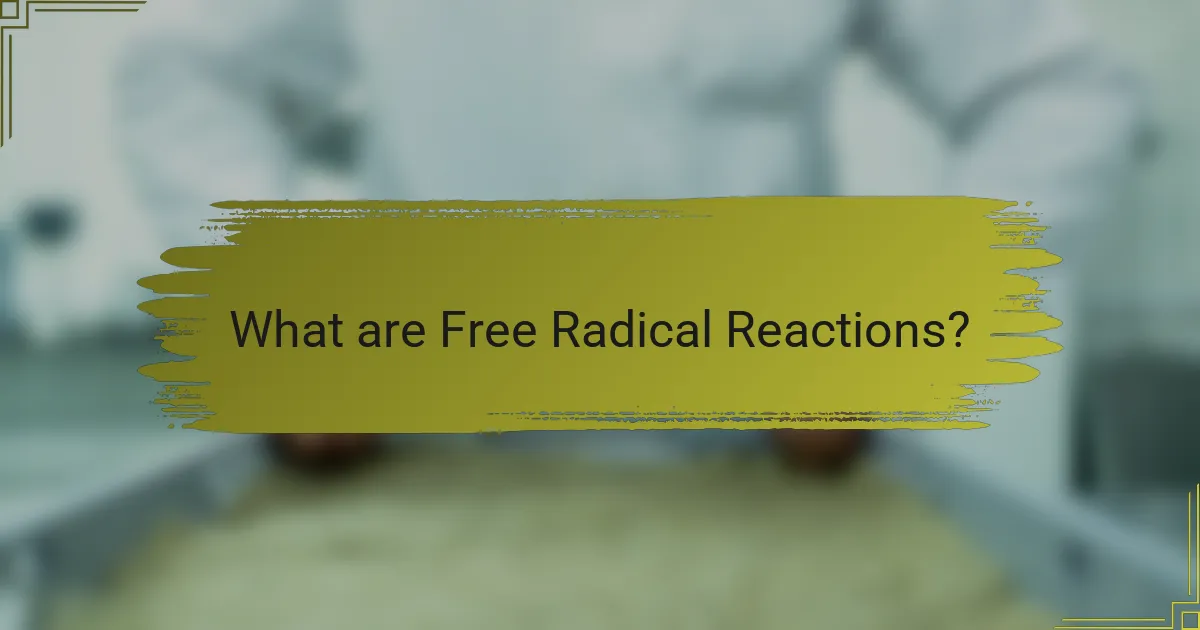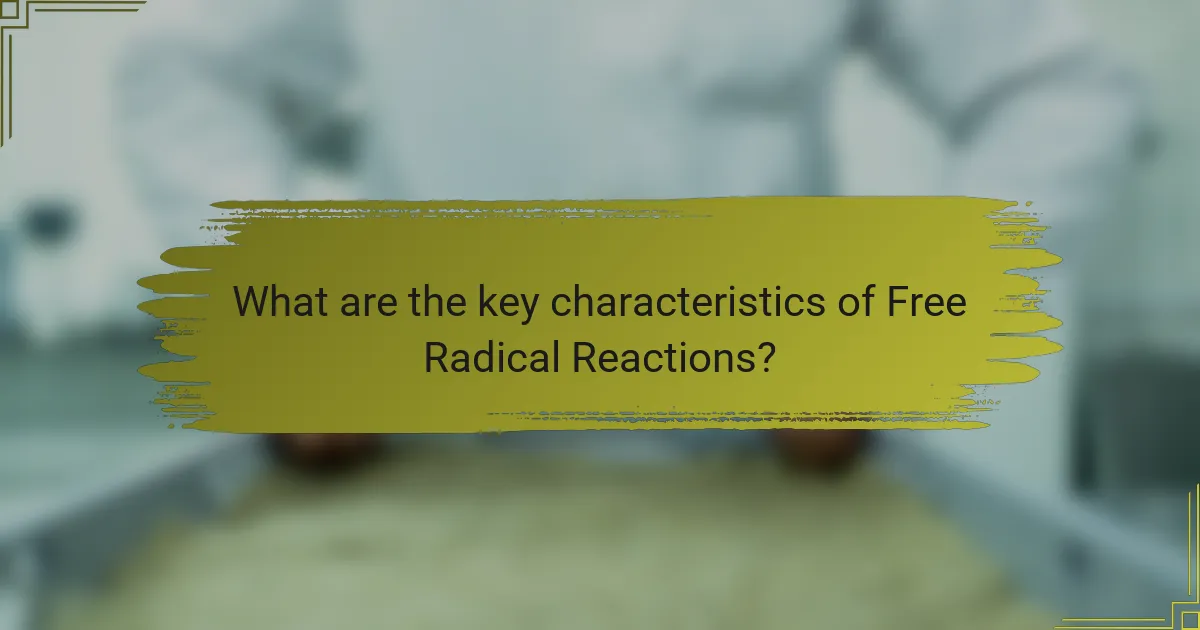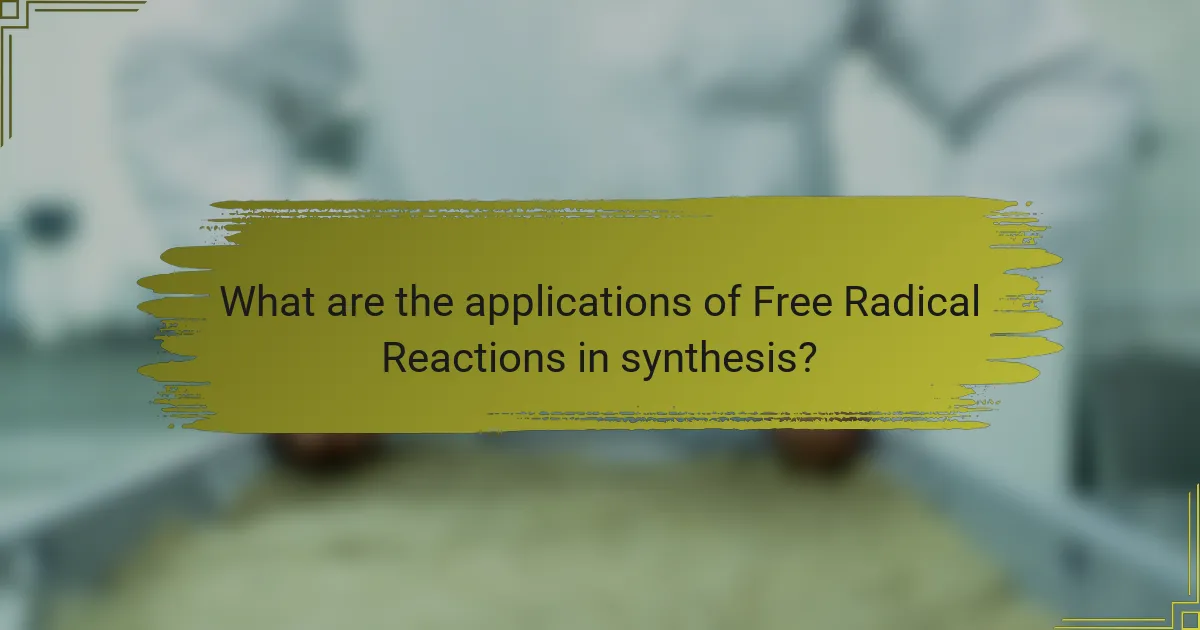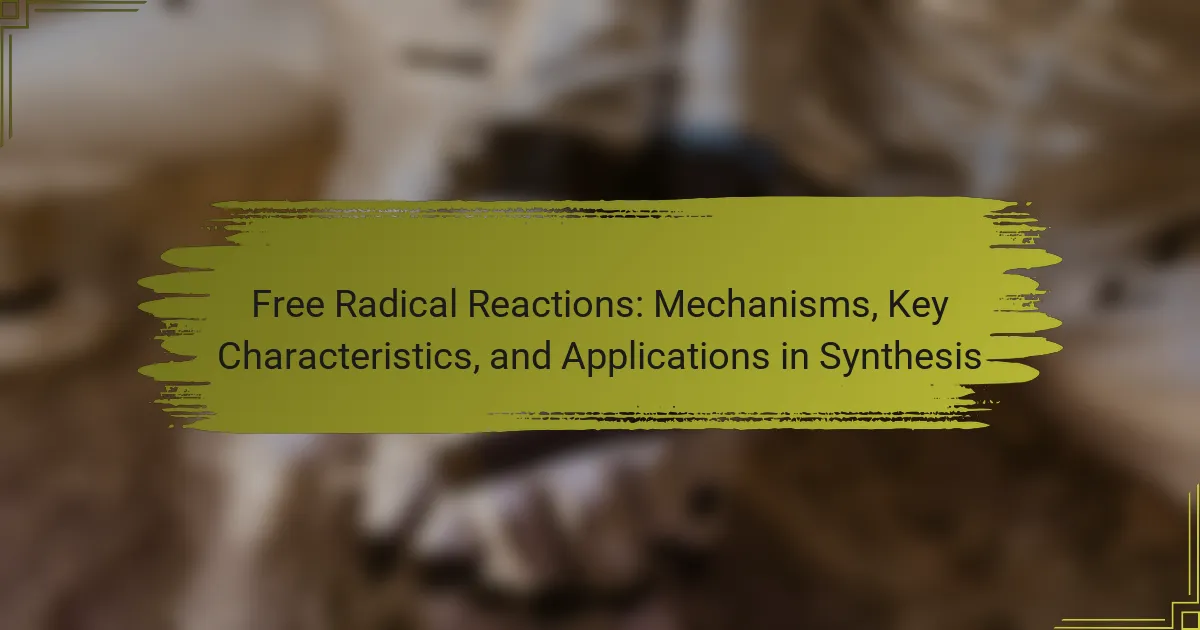
What are Free Radical Reactions?
Free radical reactions are chemical processes involving free radicals, which are highly reactive molecules with unpaired electrons. These reactions typically occur in three stages: initiation, propagation, and termination. During initiation, free radicals are generated from stable molecules, often through heat or light. Propagation involves the free radicals reacting with other molecules, leading to the formation of new radicals. This cycle continues until termination occurs, where two radicals combine to form a stable product. Free radical reactions are fundamental in various applications, including polymerization and organic synthesis. Their reactivity is crucial in processes like combustion and biological systems.
How do Free Radical Reactions occur?
Free radical reactions occur through the formation and interaction of free radicals. A free radical is an atom or molecule with an unpaired electron. These radicals are highly reactive and seek to pair their unpaired electron with another atom or molecule. The process typically begins with the initiation step, where a stable molecule is broken down to form free radicals. This can occur through heat, light, or chemical reactions.
Once formed, free radicals undergo propagation, where they react with other molecules, creating new radicals. This chain reaction continues until a termination step occurs, where two free radicals combine to form a stable product. Free radical reactions are crucial in various chemical processes, including polymerization and combustion. Studies show that these reactions play a significant role in biological systems, influencing aging and disease.
What are the key steps in the mechanism of Free Radical Reactions?
The key steps in the mechanism of free radical reactions are initiation, propagation, and termination.
Initiation involves the formation of free radicals from stable molecules. This can occur through heat, light, or chemical reactions.
Propagation consists of a series of steps where free radicals react with stable molecules. Each reaction produces a new free radical, continuing the chain reaction.
Termination occurs when two free radicals combine to form a stable product. This step stops the chain reaction.
These steps are essential for understanding how free radical reactions proceed in various chemical processes.
What types of free radicals are involved in these reactions?
Types of free radicals involved in these reactions include alkyl radicals, aryl radicals, and peroxyl radicals. Alkyl radicals are formed from the homolytic cleavage of carbon-hydrogen bonds. Aryl radicals arise from the removal of a hydrogen atom from an aromatic compound. Peroxyl radicals are generated from the reaction of oxygen with organic compounds. Each type of radical plays a distinct role in various chemical reactions. Their reactivity and stability differ significantly. For example, alkyl radicals are generally more stable than aryl radicals. This stability influences the pathways of free radical reactions in synthesis.
Why are Free Radical Reactions significant in chemistry?
Free radical reactions are significant in chemistry because they play a crucial role in various chemical processes. These reactions involve highly reactive species known as free radicals, which can initiate chain reactions. Free radicals are formed during processes such as combustion, polymerization, and biological metabolism. Their reactivity allows them to participate in diverse synthetic pathways. For example, in organic synthesis, free radical reactions can create complex molecules efficiently. Additionally, they are essential in understanding mechanisms of reactions in atmospheric chemistry. Research indicates that free radicals are involved in ozone depletion and other environmental processes. This highlights their importance in both synthetic chemistry and environmental science.
What benefits do Free Radical Reactions provide in synthetic chemistry?
Free radical reactions provide several benefits in synthetic chemistry. They facilitate the formation of complex molecules through efficient bond cleavage. This process allows for the generation of reactive intermediates, which can lead to diverse product formation. Free radical reactions often occur under mild conditions, reducing the need for harsh reagents. They can also proceed rapidly, enhancing overall reaction rates. Additionally, these reactions can achieve high selectivity, allowing for targeted synthesis of desired compounds. Their versatility makes them applicable in various fields, including pharmaceuticals and materials science.
How do Free Radical Reactions compare to other types of chemical reactions?
Free radical reactions differ from other chemical reactions primarily in their mechanism and reactivity. They involve highly reactive species with unpaired electrons, known as free radicals. This leads to chain reactions, where one radical generates another, unlike many other reactions that are more straightforward and do not involve such propagation.
In contrast, ionic and covalent reactions typically involve the transfer or sharing of electrons without the formation of radicals. Free radical reactions often occur rapidly and can be initiated by heat, light, or chemical initiators.
Statistical data shows that free radical mechanisms are crucial in processes like polymerization and combustion. Their unique behavior allows them to participate in reactions that may not occur via other pathways. For instance, the oxidation of organic compounds often involves free radical mechanisms, demonstrating their significance in organic chemistry.

What are the key characteristics of Free Radical Reactions?
Free radical reactions are chemical processes involving highly reactive species with unpaired electrons. These reactions typically proceed through three main stages: initiation, propagation, and termination. In the initiation stage, free radicals are generated, often through heat or light. The propagation stage involves the radicals reacting with stable molecules, creating new radicals and continuing the reaction chain. Termination occurs when two radicals combine, forming a stable product and ceasing the reaction. Free radical reactions are characterized by their ability to occur rapidly and their sensitivity to reaction conditions. They play a significant role in various applications, including polymerization and organic synthesis.
What are the fundamental properties of free radicals?
Free radicals are atoms or molecules that contain unpaired electrons. This characteristic makes them highly reactive. They can readily engage in chemical reactions with other substances. Free radicals are often formed through processes such as combustion, radiation, or chemical reactions. They can initiate chain reactions, leading to the formation of new radicals. Their reactivity can result in the alteration of cellular structures. This property is significant in biological systems, influencing aging and diseases. Studies have shown that free radicals play a role in oxidative stress, impacting health and longevity.
How do free radicals differ from other reactive species?
Free radicals differ from other reactive species primarily due to their unpaired electrons. This unpaired electron makes free radicals highly reactive, seeking to pair with other electrons. Other reactive species, such as ions or molecular species, may have paired electrons or different reactivity profiles. For example, reactive oxygen species (ROS) include both free radicals and non-radical species, but not all ROS are free radicals. The unique reactivity of free radicals often leads to chain reactions, which is not a common characteristic of other reactive species. Research shows that free radicals can initiate polymerization processes, differentiating them from other species in chemical reactions.
What factors influence the stability of free radicals?
The stability of free radicals is influenced by several key factors. These factors include the degree of resonance stabilization, the electronegativity of adjacent atoms, and steric hindrance. Resonance stabilization occurs when free radicals can delocalize their unpaired electrons across multiple atoms, enhancing stability. For example, allylic and benzylic radicals are more stable due to resonance effects. Electronegativity plays a role as electronegative atoms can pull electron density away, making radicals less stable. Steric hindrance affects stability by increasing the spatial crowding around the radical, which can destabilize it. Additionally, the overall molecular structure and the presence of substituents can further influence radical stability.
How do Free Radical Reactions impact reaction rates?
Free radical reactions significantly increase reaction rates. This occurs due to the high reactivity of free radicals. Free radicals can initiate chain reactions, leading to rapid consumption of reactants. The presence of free radicals lowers the activation energy required for subsequent reactions. Consequently, reactions proceed faster compared to non-radical pathways. For instance, in polymerization processes, free radical mechanisms lead to quicker formation of polymers. Studies show that reactions involving free radicals can be several orders of magnitude faster than traditional mechanisms. Overall, the impact of free radicals on reaction rates is marked by increased speed and efficiency in chemical processes.
What role does temperature play in Free Radical Reactions?
Temperature significantly influences free radical reactions. Higher temperatures increase the kinetic energy of molecules. This elevation in energy leads to a higher frequency of collisions between reactants. As a result, the rate of reaction typically accelerates. Additionally, elevated temperatures can enhance the formation of free radicals. This occurs through the breaking of chemical bonds, which requires energy input. Conversely, lower temperatures can slow down these reactions. This is due to decreased molecular motion and fewer collisions. Therefore, temperature is a critical factor in determining the efficiency and speed of free radical reactions.
How does concentration affect the behavior of free radicals?
Concentration significantly influences the behavior of free radicals. Higher concentrations of free radicals increase the likelihood of reactions with other molecules. This leads to enhanced reactivity and potential chain reactions. In contrast, lower concentrations result in reduced interaction rates. Consequently, this diminishes the overall reactivity of free radicals. Research shows that in chemical reactions, concentration impacts the rate of radical formation and termination. For instance, in polymerization processes, higher radical concentrations can accelerate the reaction rate. This demonstrates that concentration is a critical factor in determining the behavior of free radicals in various chemical contexts.

What are the applications of Free Radical Reactions in synthesis?
Free radical reactions have several applications in chemical synthesis. They are utilized in polymerization processes to create various plastics and synthetic fibers. These reactions enable the formation of complex organic molecules through functionalization of hydrocarbons. Free radicals are also employed in the synthesis of pharmaceuticals, enhancing the efficiency of drug development. Additionally, they are used in the modification of natural products to improve their properties. The versatility of free radical reactions makes them essential in materials science and organic chemistry.
What industries utilize Free Radical Reactions for synthesis?
The chemical and pharmaceutical industries utilize Free Radical Reactions for synthesis. These reactions are crucial for producing a variety of compounds. In the chemical industry, they are used to create polymers and plastics. The pharmaceutical industry employs them for synthesizing active pharmaceutical ingredients. Additionally, the cosmetics industry uses Free Radical Reactions for formulating products like antioxidants. Research indicates that these reactions enable the formation of complex molecules efficiently. Studies show that Free Radical Reactions can lead to high yields in synthesis processes. This demonstrates their significance across multiple sectors.
How are Free Radical Reactions applied in pharmaceuticals?
Free radical reactions are applied in pharmaceuticals primarily for drug synthesis and modification. These reactions facilitate the formation of complex molecules by enabling the creation of new bonds. They are crucial in developing various therapeutic agents, including anti-cancer drugs. For example, free radical mechanisms are used in the synthesis of compounds like paclitaxel, an important chemotherapeutic agent. Additionally, they are employed in polymerization processes for drug delivery systems. This application enhances drug stability and control over release rates. The versatility of free radical reactions makes them valuable in pharmaceutical research and development.
What role do Free Radical Reactions play in polymer manufacturing?
Free radical reactions are crucial in polymer manufacturing as they initiate and propagate polymerization processes. These reactions involve the formation of free radicals, which are highly reactive species with unpaired electrons. In the context of polymerization, free radicals can initiate the chain reaction that leads to the growth of polymer chains.
The process typically begins with a free radical initiator, which decomposes to generate free radicals. These radicals then react with monomers, forming new radicals that continue the chain reaction. This method is widely used in producing various polymers, such as polyethylene and polystyrene.
Free radical polymerization is favored for its ability to produce polymers with controlled molecular weights and structures. According to research by Odian, G. (2004) in “Principles of Polymerization,” this technique is essential for creating a diverse range of polymer materials used in numerous applications.
What are the challenges associated with Free Radical Reactions?
Free radical reactions face several challenges that can affect their efficiency and outcomes. One significant challenge is the lack of selectivity, leading to unwanted side reactions. These reactions can produce multiple products, complicating purification processes. Another challenge is the instability of free radicals, which can lead to premature termination of reactions. Additionally, controlling the reaction conditions, such as temperature and solvent choice, is crucial for optimal results. The presence of inhibitors or scavengers can also hinder free radical reactions by consuming radicals before they can react with desired substrates. Furthermore, the formation of stable radical intermediates can complicate mechanistic understanding and reaction pathways. Overall, these challenges necessitate careful planning and optimization in synthetic applications involving free radical chemistry.
What are common pitfalls in utilizing Free Radical Reactions?
Common pitfalls in utilizing free radical reactions include poor control of reaction conditions. Inadequate temperature or pressure can lead to unwanted side reactions. Another issue is the formation of stable radical intermediates, which can reduce reaction efficiency. Additionally, the presence of oxygen can cause premature termination of radical chains. Incomplete understanding of the mechanism may result in incorrect assumptions about reaction pathways. Moreover, the choice of solvents can significantly affect radical stability and reactivity. Lastly, not accounting for the reactivity of different radicals can lead to unpredictable outcomes. These pitfalls highlight the importance of careful planning and execution in free radical chemistry.
How can one mitigate risks when working with free radicals?
To mitigate risks when working with free radicals, one should employ several safety measures. First, use appropriate personal protective equipment (PPE) such as gloves, goggles, and lab coats. This equipment minimizes direct exposure to reactive species. Second, conduct experiments in a fume hood to prevent inhalation of harmful vapors. Third, maintain proper storage of chemicals to avoid unintended reactions. Fourth, utilize inert atmospheres when necessary to reduce free radical formation. Additionally, implement rigorous training for personnel on handling free radicals safely. These practices are essential as free radicals can cause oxidative damage and pose health risks.
What best practices should be followed when conducting Free Radical Reactions?
Use appropriate safety equipment when conducting free radical reactions. This includes gloves, goggles, and lab coats to protect against harmful substances. Maintain an inert atmosphere, such as nitrogen or argon, to prevent unwanted side reactions with oxygen or moisture. Control the temperature to optimize reaction rates and minimize side reactions. Use radical initiators that are well-characterized and suitable for the specific reaction conditions. Monitor the reaction progress using techniques like TLC or NMR to ensure desired outcomes. Dispose of all waste materials according to safety regulations to prevent environmental contamination. Proper documentation of procedures and results is essential for reproducibility and safety.
Free radical reactions are chemical processes involving highly reactive molecules with unpaired electrons, characterized by three main stages: initiation, propagation, and termination. This article explores the mechanisms of free radical reactions, the types of free radicals involved, and their significance in various applications, including polymerization and organic synthesis. Key characteristics, factors influencing stability, and the impact of temperature and concentration on reaction rates are also discussed. Additionally, the article highlights the challenges and best practices associated with utilizing free radical reactions in synthesis across multiple industries, particularly in pharmaceuticals and materials science.
